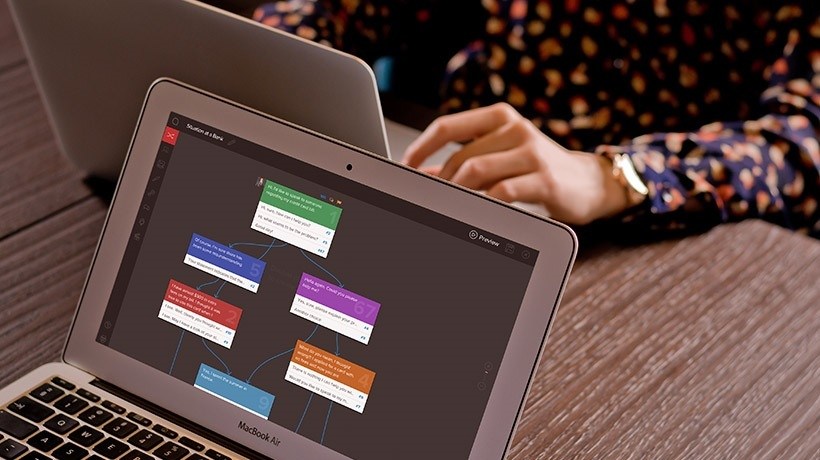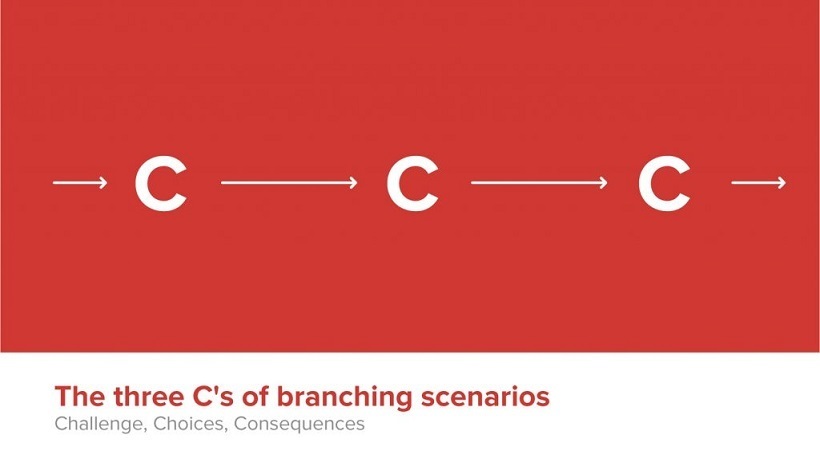The Difference Between Standard eLearning And eLearning Branching Scenarios
This is more or less the standard method of eLearning - whether it is a slide-show or a document, this method of eLearning is admittedly quite uninteresting and often hard to remember. In comparison, branching scenarios offer much more in terms of helping the learner to explore and to understand what they are learning. Today I would like to give you an overview of what branching scenarios are and why I honestly believe they are the best method of eLearning.
Let’s take a deeper look at the differences between the standard method and the branching scenario method. At its core, every eLearning course focuses on the transfer of knowledge to the user. The course explains what you will learn, describes it, and then expects you to remember it. This is a very linear path through which the course will try to transfer knowledge. The course will simply explain what the learner needs to do and then expects them to remember it. Think about it: You go from page to page, slide to slide, you memorize information as you go, and then, at the end, there will be a knowledge check which asks you some questions. This is the standard method of eLearning. This is a basic method of transferring knowledge, there is nothing inherently wrong with it; however it relies on your employees having the time, the capacity, and the willingness to memorize it.
We, as human beings, are programmed to learn through journeys and experiences. In order for something to be memorable, we need to experience it in a way that will make it memorable. We often remember conversations better if we remember what the person we were talking to looked like, the sound of their voice, and the place where we were standing at the time. Compare this with a piece of paper containing a transcript of the conversation and you should clearly understand the impact that these key differences have on our ability to remember information.
Learning is highly dependent on being able to memorize and recall information. If you want your learners to perform well after their training, you should consider that there may be a better option than standard eLearning training.
The Standard eLearning Course
The standard eLearning course focuses on one simple strategy of teaching, which in essence comes down to this: “Display the information, explain it, encourage the learner, memorize it”.
If you examine the image below, you will see what I mean. In this slide, a pilot is learning about what to do in the case of an engine failure. The slide displays several clickable buttons which will take the user to specific slides covering detailed information about some possible causes. The slide wants the user to read the information contained in each slide and recall it later during a knowledge check quiz.

The slide serves its purpose, it delivers the information required to the user, and it is up to the user to use it and remember it.
The Branching Scenario eLearning Course
If you take a look at the simplified branching scenario slide below, you should notice that it has several key differences from the standard eLearning slide.

When constructing branching scenarios we use a specific pre-planned technique in order to make them effective. This technique is called “the 3 Cs of branching scenarios”:
1. Challenge.
A challenge is the creation of the situation. A problem which needs a solution and which the learner will possibly encounter in real life. The challenge sets the scene and puts the learner in a position of power in order to create a connection between them and the information contained in the slides. The challenge in this slide is that the pilot has encountered engine failure shortly after take-off due to a bird strike.
2. Choice.
If this is a critical situation, a choice has to be made. As you can see, we have injected choices into the eLearning slide - it is no longer a simple display of information. From this point onwards, the learner is making choices as a pilot and this forces them to actually think about the information given to them. Giving the learner a choice forces them to go back to the knowledge they had learned in the previous slides and apply it. This helps reaffirm the information and greatly increases their ability to retain important information should a similar scenario occur in real life.
3. Consequence.
Each choice leads to a consequence, and these consequences are there so that the learner can learn from their mistakes. We give the learner the option to go back and make different choices too, so they can replay the scenario in their head several times until they feel confident about the right choice to make. This greatly enhances their ability to digest the information given to them.
A branching scenario can also give learners many other interactive options to help engage the learners. In our slide we have a time limit to add an interesting and very real perspective to the situation. We can also give them documentation they can consult before making their choice and offer many other interesting consulting options.
What Makes A Great Branching Scenario
Branching scenarios use David Kolb’s “learning through experience” methodology to mimic real life. Instead of a learner simply reading a flat page of words and trying to remember them, branching scenarios put knowledge into perspective by giving them a choice that leads to different consequences. Branching scenarios will continually branch out to different choices and consequences to create a complex tree which mimics real-life encounters. They connect the learner with the training course in a more natural way, which creates a deeper level of understanding. This helps to bridge the gap between linear knowledge based courses and actual job performance.
A branching scenario is the only earning method that inherently focuses on connecting the learner with the subject matter in a way that builds a rapport and puts theory into practice before a real-life situation arrives.
Linear (Fake) Branching Vs. Non-Linear (Real) Branching
Once you begin to grasp the idea of how a branching scenario works, you might get excited at the prospect of creating a great scenario. However, there are a few common pitfalls to watch out for. A branching scenario in theory should be fairly easy to understand, but we often find that some supposed branching scenarios are in fact very linear and not fit for purpose.
Creating an eLearning course using branching scenarios is not about simply adding consequences to choices in a linear fashion. It is about creating an engaging simulation which offers insight into the subject matter you would like the user to learn about. A great branching scenario is not merely a presentation of information, it is the experience of a journey. To do that, you have to make sure you are creating a genuine branching scenario and not a linear fake branching scenario.
Below is an example of a fake branching scenario.

At first glance you will notice that this scenario is a big step up in the approach to building an eLearning course. It uses the same principles we talked about earlier. It connects the learner to the content by placing the learner inside a situation they may face in their job as well as adding faces, characters and interactivity.
The learner has been asked to make a choice and we are about to see the consequences of that choice.

Virginia walks out (bad choice) and, instead of continuing the journey, you are prompted to go back and try again. This is an example of a fake branching scenario. It leads you down a single path by pretending to be branching. There is no depth to the interaction, there is no journey. A typical fake branching scenario will take a linear path like this.

It gives you several choices - however, all choices but one are wrong and the learner moves down a single path already set out for them with no room to discover and learn in a more engaging manner.
Compare this with a real non-linear branching scenario as shown in the image below.

It starts in the same way as the previous scenario. It will use the 3 Cs methodology (Challenge, Choice, Consequence), but each of the consequences will lead the learner down a different path with different outcomes. This allows for a greater variety of challenges within the scenario and helps the learner to forge their own journey and learn from their mistakes in a more natural manner than a linear fake branching scenario.
A real branching scenario can be harder to build, as it is complex, but it makes the scenario very interesting to the learner. It encourages them to go back and make smarter choices until the they find the outcome they are looking for.
Another way, in which real branching scenarios push the boundaries of learning through experience, is that they will not immediately give feedback about the choice. The learner must continue on with their journey to an endpoint, where they see the result of the culmination of their choices. This solidifies their understanding of what happened and why the choices they made led to that particular outcome. As demonstrated by the studies and theory behind David Kolb’s experiential learning cycle, learning through experience has been proven scientifically to very likely be the best way to learn. This is why a real non-linear branching scenario works so well as an eLearning course.
In Conclusion
Unlike traditional linear courses, branching scenarios offer engaging situations for learners to participate in and realistic problems to solve, be it selling a product to a customer or discussing a patient’s condition in a hospital. Scenarios improve knowledge retention and learner engagement.
However, scenarios that offer minimal branching and push the learners down a single correct path are not very engaging and can be easily spotted by learners. Building a real complex branching scenario would elevate your learning to an entirely new level.
BranchTrack is a tool built specifically to take complexity out of scenarios. Create scenarios in a user-friendly browser-based editor. You can share your scenario with others, gather feedback and make changes almost instantly. You will have access to dozens of different characters to use in your scenarios, each with a range of emotions and poses. All of the scenarios created with BranchTrack are responsive and will easily work on mobile phone or tablet. They can even be embedded into eLearning courses built with other tools!








